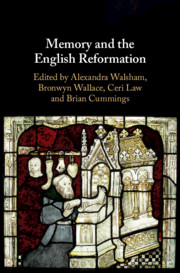Book contents
- Memory and the English Reformation
- Memory and the English Reformation
- Copyright page
- Dedication
- Contents
- Figures
- Contributors
- Preface and Acknowledgements
- Abbreviations
- Introduction
- Part I Events and Temporalities
- Part II Objects and Places
- 7 Dolls and Idols in the English Reformation
- 8 Monuments and the Reformation
- 9 Memorable Motifs
- 10 Revitalising Antiquities
- 11 Rereading Ruins
- 12 ‘Monuments of Our Indignation’
- Part III Lives and Afterlives
- Part IV Rituals and Bodies
- Index
9 - Memorable Motifs
The Role of ‘Synoptic’ Imagery in Remembering the English Reformation
from Part II - Objects and Places
Published online by Cambridge University Press: 30 October 2020
- Memory and the English Reformation
- Memory and the English Reformation
- Copyright page
- Dedication
- Contents
- Figures
- Contributors
- Preface and Acknowledgements
- Abbreviations
- Introduction
- Part I Events and Temporalities
- Part II Objects and Places
- 7 Dolls and Idols in the English Reformation
- 8 Monuments and the Reformation
- 9 Memorable Motifs
- 10 Revitalising Antiquities
- 11 Rereading Ruins
- 12 ‘Monuments of Our Indignation’
- Part III Lives and Afterlives
- Part IV Rituals and Bodies
- Index
Summary
This chapter focuses attention on a visual motif that became synonymous with the Reformation; the scales of justice weighing the Bible against the vanities of the Roman Catholic Church. It traces the migrations and mutations of this iconography in English visual culture from the 1570s to the 1670s, examining the contexts in which it appeared and was viewed, including canonical Protestant texts, popular print, domestic decoration and the battlefields of the civil war. It is argued that, in contrast to the pictorial elaboration of similar iconography in reformed continental art, an ‘insular’ process of visual compression enhanced the efficiency and immediacy of this motif’s message of Protestant righteousness. In this synoptic form the imagery served practices of ideological and social cohesion as well as fuelling conflict and division. Like memory itself, the ‘weighing motif’ was repeatedly remade; it was reiterated but modified as it transferred between and across objects, places and spaces. Its success as a particularly memorable motif encapsulates an understanding of the Reformation as both defining historical event and incremental process; while its imagery commemorated a single moment of judgement effecting schism, its persistence and longevity emphasised and facilitated the ongoing struggle for reform.
Keywords
- Type
- Chapter
- Information
- Memory and the English Reformation , pp. 185 - 206Publisher: Cambridge University PressPrint publication year: 2020

